Readers of this blog probably know that early-modern book bindings contain hidden treasure: fragments cut from medieval manuscripts, ranging from small snippets to full pages. The fragments were placed inside bindings to reinforce the bookblock and to provide support for the boards (see this post I wrote about it, and this one as well). This recycling process – plain-old slicing and dicing, really – was common practice, old-fashioned as handwritten books had become after the invention of print. In fact, medieval pages are found in as many as one in five bindings of printed books from the sixteenth and seventeenth centuries. While the stowaways are normally hidden from our eyes, we sometimes get to meet them face to face when a binding is damaged (Fig. 1).
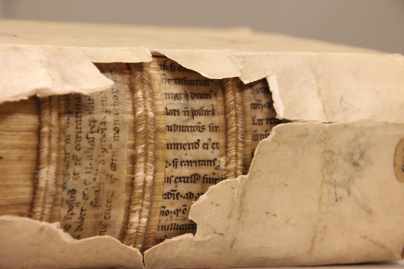
But what to do with the thousands of fragments that are hidden from us in bindings that are still in pristine condition? This simple question became the drive behind the development of a method to examine fragments without removing or damaging the bindings. The method, which was presented this week, encompasses medieval book history (executed by me) and Macro X-ray Fluorescence Spectrometry (developed by Joris Dik, Delft University).This post gives you an exclusive look behind-the-scenes at how we managed to digitally leaf through invisible pages and gain access to a hidden library.
The plan
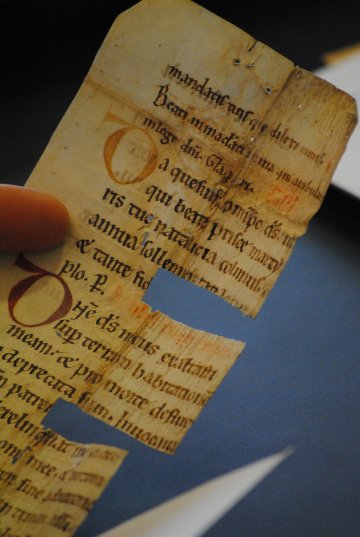
In the spring of 2014 I was asked to write a short piece about ideas or approaches that could potentially change a scholarly discipline, even if they were not yet feasible. I wrote about how we might be able to access a hidden medieval “library” if we were able to gain access to the thousands of manuscript fragments hidden in bindings (Fig. 2). Take their carriers– printed books whose bindings are enforced with the fragments – and give them a ride on the luggage belt at Schiphol Airport in Amsterdam. Let’s give them a bit of x-ray love, I suggested, half jokingly (here is the piece I wrote).
Then I remembered that a fellow member of The Young Academy, Joris Dik, developed an x-ray technology that enables researchers to look through paintings, in search of the earlier stages of the composition. Joris and I secured funding through The Young Academy to transport his Macro X-ray Fluorescence Spectrometry (or MA-XRF) scanner to Leiden University Library, an institution that greatly supported the unusual kind of research we were planning to undertake. We dubbed our endeavour the “Hidden Library” project and on October 4th, 2015 we started firing away at early-modern bindings in Leiden University Library.
The theory
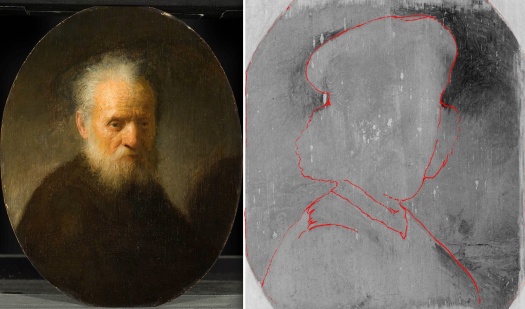
The Macro X-ray Fluorescence Spectrometry (MA-XRF) technology was developed by Joris Dik and his team at Delft University, in collaboration with industrial, academic and museum partners. The machine was designed in such a way that it could be transported to a museum in a few crates. There it would be used to show hidden paint layers in paintings by Rembrandt and other old masters. For example, in collaboration with partners in Antwerp Joris Dik successfully showed an unfinished self-portrait by Rembrandt, which was hidden underneath a painting of an old man (Fig. 3) – here is a more recent Rembrandt discovery. A thin beam of X-rays is used to scan the object, charting the presence and abundance of various elements below the surface. Theoretically, the technology ought to make it possible to show medieval inks as well, even when they are covered by a layer of parchment, paper or leather – the most common materials that hide medieval binding fragments from our eyes. But would it?
The practice
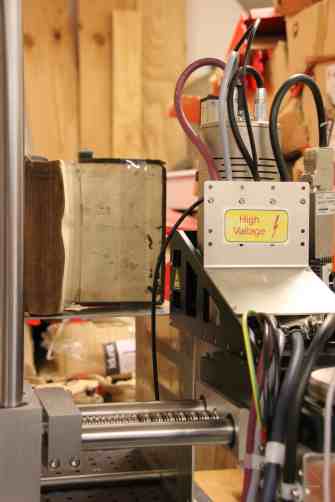
The answer to this question came very quickly after we hit the switch: yes. However, interdisciplinary research often comes with complications. Yes, we see text, but no, we could not read it. And so a series of experiments were undertaken by the team (which also included two research assistants, Anna Käyhkö and Jorien Duivenvoorden). For one thing, we learned that the distance between the head that released the x-ray beam and the fragment in the binding was key to our success (Fig. 5). A device was built that allowed us to adjust this distance between head and fragment with half a millimeter (the image was taken before it was completed).

Another variable we had to master was the length of time needed to scan the fragment. The head was moving back and forth in front of the scanner (Fig. 4), but how slow did this movement need to be? How long should the scanner scan before moving on to the next bit? When was it clear enough for me to read? Ultimately these nuts were cracked, meaning we were able to see a fragment through a binding. In fact, we managed to do it in such a way that the text was clear, legible and datable, as the following examples show (Figs. 6-8).
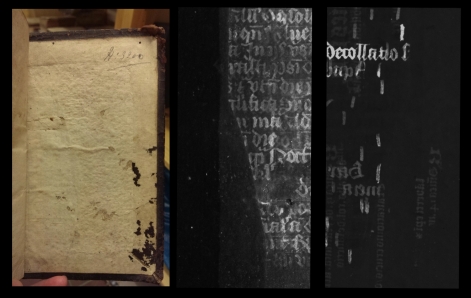
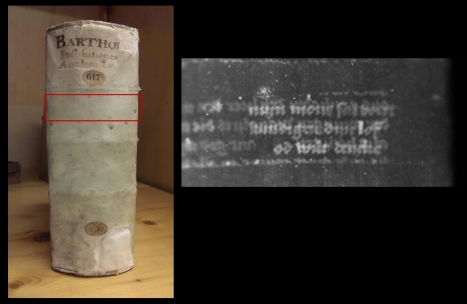
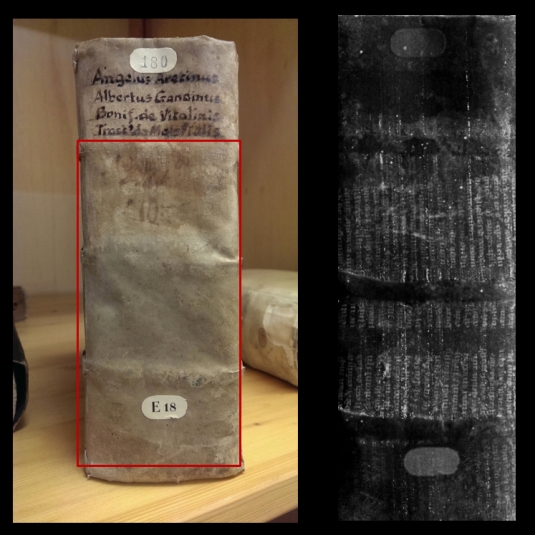
We ultimately scanned around twenty different early printed books. This seems a modest amount, but the main aim of the Hidden Library project was to discover if we could indeed expose bindings to x-rays and reveal the medieval fragments inside. In that respect the project was a success.
Challenges for the future
Before we start thinking that this method will enable us, starting right now, to trace thousands of new fragments, we are forced to take a reality check. First of all, the second variable – of how long a binding needed to be scanned in order to reveal its hidden treasure – remains a practical road block between science and unveiling a medieval source that has never been tapped into systematically. The images you see in Fig. 6-8 were each produced with over 24 hours of scanning time. A shorter period makes fragments visible, but not legible, as seen in Fig. 9 (which shows the same fragment as in Fig. 6, yet exposed significantly shorter).
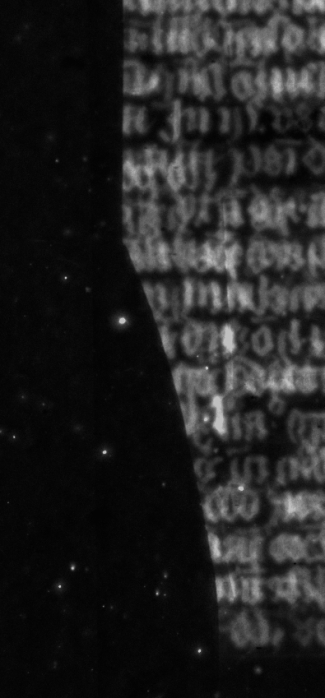
Secondly, another problem is to distinguish between the text on the front and back of the fragment. Depending on the composition of the ink, it may or may not be possible to separate the two sides of a leaf. Iron, for example, will be returned from both sides of a leaf, producing a peculiar image like the one seen in Fig. 10. One has to look for elements that only show the side closest to the beam, which in this case is calcium. Consequently, this particular fragment is seen in its most optimal form when only calcium is shown, as is the case in Fig. 6.

So yes, the new technique is amazing in that it shows us fragments – medieval text – that we could otherwise never see because they are hidden behind a layer of parchment or paper. However, the method is not yet perfect in that it comes with challenges that need to be overcome, of which the long exposure time is the most significant. To stay within the analogy of this post, while the door to a virtual medieval library has been opened by the MA-XRF technique, we need to find a way to enter and take a look around as quickly and efficiently as we would in a real library.
Credits
The interdisciplinary research introduced here was executed by Joris Dik (Delft University) and Erik Kwakkel (Leiden University) in close collaboration with the University Library Leiden. Fundamental in our research was the help of the library’s conservator, Karin Scheper (who is, by the way, a guest blogger for medievalbooks). Two research assistants worked with us for the duration of the project: Anna Käyhkö and Jorien Duivenvoorden. The project was financed by De Jonge Akademie (The Young Academy), a branch of the Koninklijke Nederlandse Academie van Wetenschappen (The Royal Dutch Academy of Arts and Sciences). Two formal publications, providing a more detailed description of the research and its results, are planned. Various national Dutch news outlets have paid attention to the project (newspaper, radio [start at 9.50 min] and television [start at 20 sec.]).

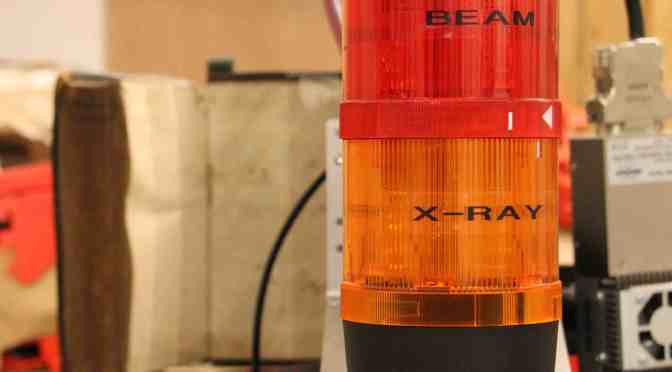
Late reactie, maar ik las dit nu pas (via een vermelding van het Smithsonian). Wat een geweldige toepassing van deze techniek, wie weet wat er boven komt, dit opent allerlei mogelijkheden. Ook interessant dat dit weer een andere fysieke verschijningsvorm van een ‘palimpsest’ is. Goed werk zeg!
LikeLike
Great stuff and very interesting. So glad to have found you!
LikeLike
Thanks for this!
LikeLike
Reblogged this on Heron Moon Education Services & Press and commented:
I’ve always been fascinated by the history of the book and book ownership. In fact, when I was doing my graduate studies in medieval Irish literature, I was often more interested in the marginalia that contained the owners’ commentary than the narrative on the pages. I would also look at the genealogy that some bound manuscripts contained and wonder about these individuals listed and what their lives were like. To find out that people are now able to find repurposed (or destroyed if one looks at it this way) manuscript pages in the bindings of early printed books is to know that there is a whole history of ownership living just out of reach. Who chose to discard these pages? What made them expendable outside of the fact that printing was making book ownership and dissemination more accessible to more of the population?
Although my interests have begun to lean towards the modern short story, my interest in ownership and literacy stands strong. These new discoveries may tell us more about the transition to print and changes in literary culture.
LikeLiked by 1 person
Re-blogged on Great Parchment Book website at http://www.greatparchmentbook.org/ – another collaborative project revealing hidden treasure!
LikeLike
Re-blogged on Great Parchment Book website at http://www.greatparchmentbook.org/ – another collaborative project to digitally reveal hidden treasures.
LikeLike
Not quite, I think: a tiff is uncompressed and thus larger (and it therefore takes longer to load into the printer). A longer scan looks at a given place longer, increasing the resolution of the image it produces.
LikeLike
Wow! my father was a radiologist.He would be amazed at what x-rays can do today.When you print a tiff, it takes longer than a jpeg.Is that an analogy to your 24-scan being legible?
LikeLike
This is so cool! It’s amazing to think that, once the methodology is perfected, we might gain the equivalent of entire libraries full of additional medieval sources.
LikeLike
Yes we have, but the books are not important enough to move them elsewhere (by comparison to Archimedes) and so we’ll deal with them in situ.
LikeLike
Instead of bringing a portal x-ray source to a library, have you considered taking the books to a higher-flux x-ray source like a synchrotron? Uwe Bergmann at SSRL has done similar work with Archimedes Palimpsest: http://www.slac.stanford.edu/gen/com/images/technical%20summary_final.pdf
LikeLike
Thanks for your kind comment!
LikeLike
Wonderful technique! To think that undiscovered – sometimes even unsuspected – texts may lie beneath the bindings. I intend to keep an eye on developments, if I know where I have to look.
We bibliophiles all thank you, team.
LikeLiked by 1 person
Reblogged this on Alexandra Vidal and commented:
Os livros escondem muitos segredos…
LikeLiked by 1 person